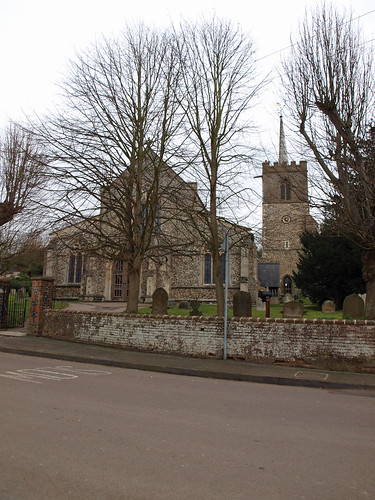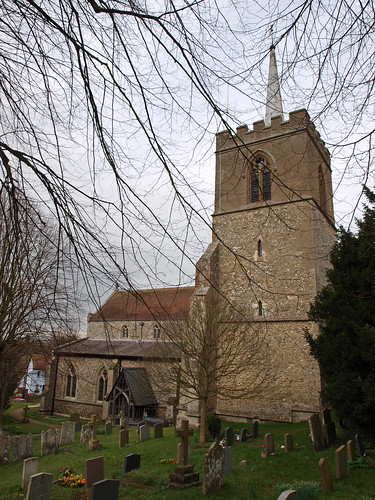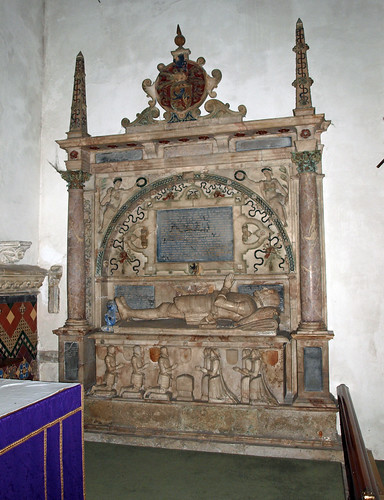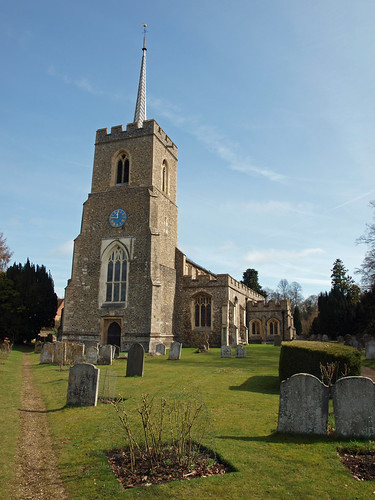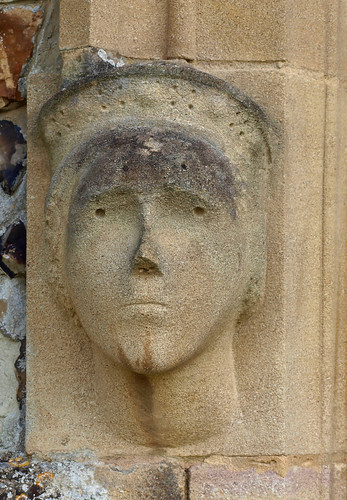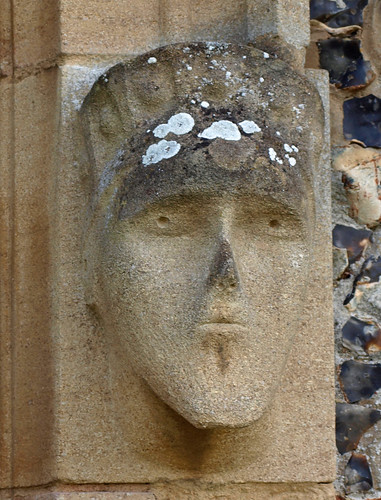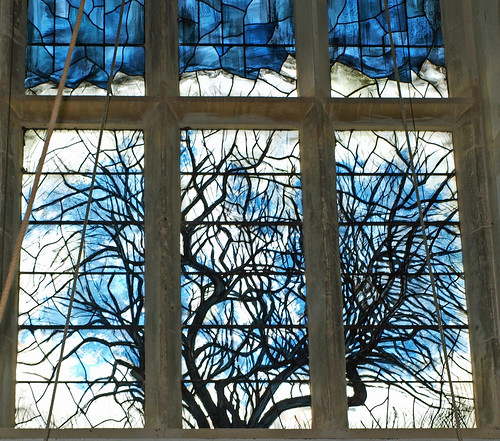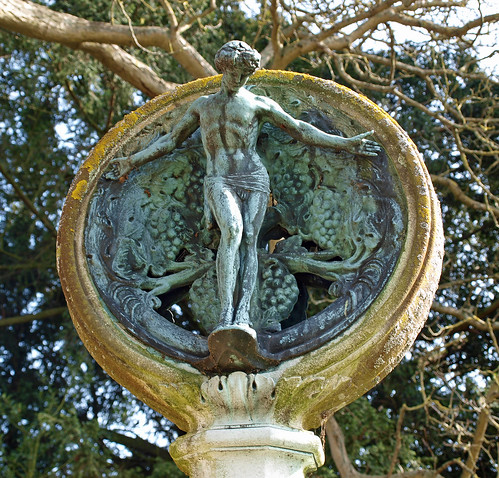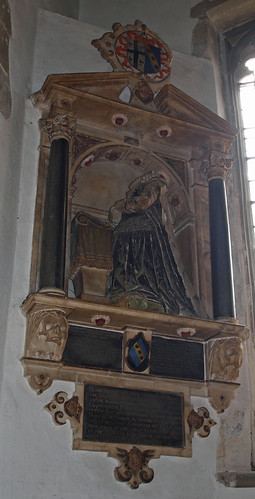St Mary is thought to replace a much earlier Saxon church to which the present 13th century chancel was added. The nave and aisles are fine examples of the Decorated period of the late 14th century with tall arches, a clerestory above and a magnificent window above the west door. The church, along with 140 acres of land was bequeathed in 1199 to the Knights of St. John, whose hospice still stands close by and was still the church school until 1974. The Knights remained in possession of the church until the dissolution of the monasteries in the 16th century.
The church is built of uncut flints, originally arranged in a chessboard pattern, but altered when the church was restored in 1864 and re-arranged without any pattern. The tower did not then join the church; a square plot of grass bounded by two walls being between the church and the tower, until this was filled in and used as an organ chamber for an organ installed in 1865. The older organ and the singers’ gallery above the west door were then cleared away. A new organ was built in 2000, occupying a position in the South aisle.
On entering the church one is immediately struck by the height of the chancel, there being a gentle slope the whole way up from the west end to the sanctuary, which is thirteen steps above the level of the nave . This construction is most unusual and occurs only in churches built by the Knights of St. John. They are called "processional" churches.
The chancel arch is Early English with fine dog-tooth moulding ornamentation. The Devonshire marble pillars however were erected at the time of the major restoration in 1864. At that date the lancet windows were inserted in the north and south walls of the chancel and a fine 15th century east window was replaced by the present window of three lights in the Early English style. On each side of the chancel arch are openings, or hagioscopes, which at one time went down to the floor of the chancel. The stone staircase to the right of the chancel arch and the opening above leading to the rood loft, remain. Of the rood loft itself no traces are left.
In the wall of the south aisle, where formerly was the Lady Chapel, is a stone coffin under a floriated arch. This is thought to have belonged to an earlier church. The font is much restored but parts of it are of the 12th century.
There are several interesting monuments. In the north aisle stands the altar tomb of John Field, an Alderman of London, who died in 1477. The brasses on this tomb show Alderman Field in a long, loose robe, with the Squire, his son, alongside him in an elaborate suit of armour. At the foot of the tomb are the three children of the Alderman and his four grand-children.
On the south side of the chancel is an impressive monument to Sir Ralph Sadleir, who died in 1587. The 80 years of his life were eventful ones. He entered the service of Henry VIII as a young man and became a gentleman of the Privy Council. He was three times sent on an embassy to James V of Scotland and on the last of these occasions was commissioned to negotiate a marriage between Prince Edward and the newly-born Princess Mary, the future Queen of Scots. In this he was unsuccessful. Six years later he was in Scotland again as Treasurer to the Army and returned from the battle of Pinkie with the Scottish banner, the pole, of which still stands in the chancel. The immensely strong chest, which stands in the nave near the Field tomb almost certainly carried the coin, with which the English army was paid.
Sir Ralph later became keeper to Mary, Queen of Scots and was finally, the year before he died, one of the knights of the Privy Council at her trial and execution at Fotheringay. His house, Standon Lordship, was built in 1546, though it would seem that he must have spent little time there. A fine monument in Italian marble to his son, Thomas, stands on the opposite side of the chancel. His life seems to have been less eventful, though in 1603 he entertained James I and his Scottish retinue for two nights at the Lordship on their way to London for the King's coronation.
On leaving the church, the steep climb up the churchyard rewards one with a fine view over the village and surrounding country.
ST MARY. Unique in the county in two features: the large W porch and the detached tower to the s of the E end of the aisle. The church stands on rising ground, the E parts higher than the W end. Hence the chancel is raised by a number of steps, the most impressive effect inside. The chancel is early C13, as proved by two N lancet windows and the spectacular chancel arch with three orders of big polished shafts (renewed in G. Godwin’s restoration of 1865 in pink marble) with shaft-rings and stiff-leaf capitals, and an arch with dog-tooth ornament (cf. Eastwick). When, in the mid C19, the nave was rebuilt much wider than before, side openings were cut into the W wall of the chancel to allow a freer sight of the altar. Of mid C14 work the following survives: the W doorway, the four-light Dec W window with flowing tracery, the aisle windows, especially those to the W and E, and the ogee-headed recess in the S aisle. The arcade piers are assigned to the same date, but seem later. It is a big church. The arcades have five bays. They are tall and have piers with an uncommon section (four attached semi-octagonal shafts and in the diagonals a keel between two hollows; cf. Tring) and two-centred arches. Above a (later) clerestory (with the windows above the spandrels, not the apexes of the arches). Of the C15 the tower in its present form and the big deep W porch with two windows on each side. - FONT. A very interesting early C13 design; octagonal, with two horizontal wavy bands of stylized leaves running around the bowl. - MONUMENTS. In the chancel Brass to a kneeling Knight, lower part only, 1412. - At the end of the nave Brasses to a civilian, mid C15; to a Knight of the Wade family d. 1557. - In the N aisle plain tombchest, originally with brass-shields against the sides. On the lid the exquisite brasses said to be to John Field d. 1474, a merchant of the ‘Stapull of Caleys’, and his son John Field, Squire, represented by the side of his father and in the same size (2 ft 9 in). The son is in armour. Both stand on hillocks with pretty flowers. Below the small figures of some children. The elder John Field had been rich enough to lend Henry VI £2,000 for the defence of Calais. - In the chancel standing wall monuments to Sir Ralph Sadleir d. 1587 and Sir Thomas Sadleir d. 1606. Both are monuments with recumbent effigies (Sir Ralph alone, Sir Thomas behind and a little above his wife) under arches (Sir Ralph’s shallow and decorated with fleurons, Sir Thomas’s deeper and coffered) and flanked by columns. In the spandrels of Sir Ralph’s are Victories, in those of Sir Thomas’s thin scrolls. The back walls have big bold cartouches, Sir Ralph’s also excellent ribbon Work. The tops are achievements; Sir Ralph’s has also two obelisks at the angles. Both works come obviously from leading London workshops. By the side of Sir Ralph’s monument his helmets (C16), sword (C14), spurs, and standard pole.
ST MARY. Unique in the county in two features: the large W porch and the detached tower to the s of the E end of the aisle. The church stands on rising ground, the E parts higher than the W end. Hence the chancel is raised by a number of steps, the most impressive effect inside. The chancel is early C13, as proved by two N lancet windows and the spectacular chancel arch with three orders of big polished shafts (renewed in G. Godwin’s restoration of 1865 in pink marble) with shaft-rings and stiff-leaf capitals, and an arch with dog-tooth ornament (cf. Eastwick). When, in the mid C19, the nave was rebuilt much wider than before, side openings were cut into the W wall of the chancel to allow a freer sight of the altar. Of mid C14 work the following survives: the W doorway, the four-light Dec W window with flowing tracery, the aisle windows, especially those to the W and E, and the ogee-headed recess in the S aisle. The arcade piers are assigned to the same date, but seem later. It is a big church. The arcades have five bays. They are tall and have piers with an uncommon section (four attached semi-octagonal shafts and in the diagonals a keel between two hollows; cf. Tring) and two-centred arches. Above a (later) clerestory (with the windows above the spandrels, not the apexes of the arches). Of the C15 the tower in its present form and the big deep W porch with two windows on each side. - FONT. A very interesting early C13 design; octagonal, with two horizontal wavy bands of stylized leaves running around the bowl. - MONUMENTS. In the chancel Brass to a kneeling Knight, lower part only, 1412. - At the end of the nave Brasses to a civilian, mid C15; to a Knight of the Wade family d. 1557. - In the N aisle plain tombchest, originally with brass-shields against the sides. On the lid the exquisite brasses said to be to John Field d. 1474, a merchant of the ‘Stapull of Caleys’, and his son John Field, Squire, represented by the side of his father and in the same size (2 ft 9 in). The son is in armour. Both stand on hillocks with pretty flowers. Below the small figures of some children. The elder John Field had been rich enough to lend Henry VI £2,000 for the defence of Calais. - In the chancel standing wall monuments to Sir Ralph Sadleir d. 1587 and Sir Thomas Sadleir d. 1606. Both are monuments with recumbent effigies (Sir Ralph alone, Sir Thomas behind and a little above his wife) under arches (Sir Ralph’s shallow and decorated with fleurons, Sir Thomas’s deeper and coffered) and flanked by columns. In the spandrels of Sir Ralph’s are Victories, in those of Sir Thomas’s thin scrolls. The back walls have big bold cartouches, Sir Ralph’s also excellent ribbon Work. The tops are achievements; Sir Ralph’s has also two obelisks at the angles. Both works come obviously from leading London workshops. By the side of Sir Ralph’s monument his helmets (C16), sword (C14), spurs, and standard pole.
Standon. Every day the flying man flies over it, but never again will its people look at him with such amaze as came to them one autumn day in 1784, when there arrived at Standon the first human traveller from the English skies. A stone has been set up at Standon Green End, and on it we read of an event recorded as a "wondrous enterprise successfully achieved by the powers of chemistry and the fortitude of man."
It must have seemed a fearful thing to these villagers who were looking up on that September afternoon at a great spherical object floating through the sky, slowly descending until it touched the ground in a field near by, and a voice cried out calling on the people to secure the monster. Out of it, from the car suspended beneath the great silk ball, stepped a man and a dog. The man was Vincenza Lunardi, a young Italian who had made a balloon fitted with racket-shaped wings and oars which he declared would help to control it. He had started at Moorfields, 30 miles away, on the grounds of the Honourable Artillery Company, and had been just over two hours in the air. Three living creatures had entered the car at Moorfields, Lunardi, his dog, and a cat, but, falling very low as he came to North Mimms, Lunardi had astonished a country woman walking there, and had handed her his cat for safe keeping before he rose again and came on to Standon, so completing the first successful balloon flight ever known.
This was the village’s great event; its great man lies in his tomb in the medieval church, close by the timbered school which has stood for centuries. The plan of the church is unusual, for in the 15th century a porch was added at the west end and a detached tower built beside the chancel, to which it has since been linked by an organ chamber. By this porch we come into a scene of singular beauty.
The lofty nave, with aisles, doorways, and windows 600 years old, slopes a little upwards, and eight steps mount to the 13th-century chancel, five more reaching the altar. The 700-year-old chancel arch is rich with carving, and has on each side of it a peep-hole through which the altar can be seen. Through the arch as we come in we see three lancets shining over the altar. The tomb we see high up in the chancel is that of as honourable a man as ever served our Tudor kings and queens, Sir Ralph Sadler. Here he is in stone, his seven children carved round his tomb and his armour hanging over it, with his stirrups and spurs. Resting at the tomb is a pole more thrilling than it looks, for from it waved the Royal Standard of Scotland at the Battle of Pinkie. It is over and forgotten, but in 1547 there was a plan to unite the English and the Scots by marrying Edward VI and Mary Queen of Scots. The scheme came to nothing, for the Scots were hostile and war resulted, when 16,000 Englishmen met 23,000 Scots at Pinkie, killing 6000 and routing the rest. Sir Ralph Sadler, who had spent an unhappy time in Edinburgh watching over Mary, brought back with him from the battlefield this mast of Scotland’s flag. Facing his tomb is that of his son Thomas, here in stone with his wife and their two children. We may see part of their old home (Lordship Manor) half a mile away by the river, incorporated into a house of a later day. The date 1546 on one of the stones, with Sir Ralph’s initials, show that he built it a year before the Battle of Pinkie, and it would be to this house that he brought back the standard pole.
Though the outside of the church has received a new stone face, inside everything, so far as the structure is concerned, is much as it was when the Calais merchant john Field was laid here in 1474. His brass portrait is on the top of his altar tomb with that of his son john, each with his children pictured below. There is a merchant’s mark on one of the four shields at the corners. Below the chancel steps are other brass portraits of a man of the 15th century and a soldier named Wade of the 16th, but someone has stolen the portrait of William Coffyn, Master of the Horse to Henry VIII’s third queen. The font has a fine 13th-century bowl.
The village was the home of one of the soldier poets who gave his life for us in the Great War, Robert Ernest Vernede. He was a scholar at St Paul’s School and St John’s at Oxford, and became a writer of novels and sketches and poems. He went out to France in the first few months of the war, when he was 40, was wounded soon after, and went back again. He had a fervent love of England. In one of his poems he asks the sleepers in France who will bring them fame in the coming years, and one of the last of all the poems he wrote was this noble prayer for his country:
All that a man might ask thou has given me, England,
Birthright and happy childhood’s long heartsease,
And love whose range is deep beyond all sounding,
And wider than all seas:
A heart to front the world and find God in it,
Eyes blind enow but not too blind to see
The lovely things behind the dross and darkness.
And lovelier things to be;
And friends whose loyalty time nor death shall weaken,
And quenchless hope and laughter’s golden store
All that a man might ask thou hast given me, England,
Yet grant thou one thing more:
That now when envious foes would spoil thy splendour,
Unversed in arms, a dreamer such as I
May in thy ranks be deemed not all unworthy,
England, for thee to die.
